You know straight away that any fish named the Red Devil is bound to have some quirky traits.
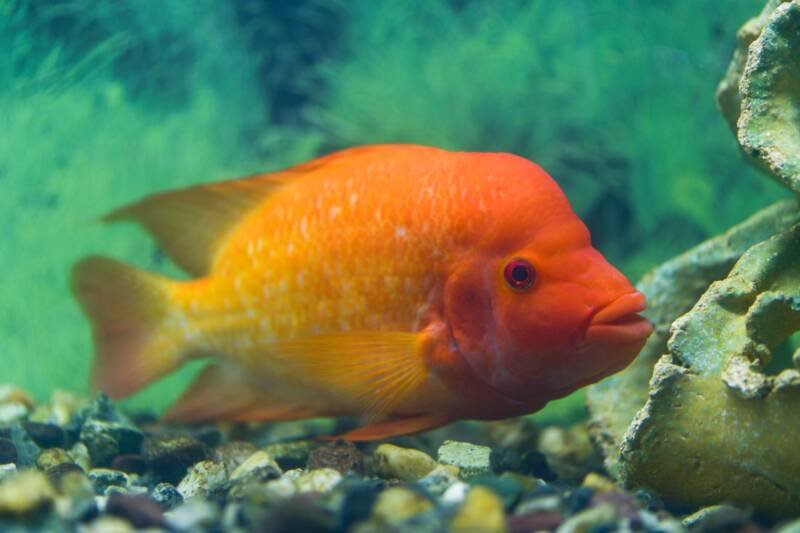
The red devil cichlid is no exception. A large, charismatic fish with a propensity for aggression but an owner-bonding response like a puppy, this Central American species makes for entertaining tank keeping.
At a Glance
| Tank size: | 55 gallons for a single fish |
| Group size: | solitary (pairs with large tank) |
| Water temperature: | 75.0-79.0 °F (24-26 °C) |
| pH: | 6.5 to 7.5 |
| Hardness: | 6 to 25 dGH |
| Lifespan: | 10 to 12 years |
| Breeding: | open spawner |
| Adult size: | 15 inches (38 cm) |
| Usual place in the tank: | entire tank |
In this article
Natural Habitat
In the wild, the red devil cichlid (Amphilophus labiatus) inhabits the Nicaragua, Managua, and Xiloa lakes.
They prefer lakes’ the calmer, open waters and tend toward rocky areas with plenty of safe hiding places.
The waters they inhabit are dark and murky, and the fish eat anything living along the lake bottom, including smaller fish, larvae, and snails.
Appearance and Biology
The red devil cichlid varies widely in color. In the wild, they tend to show darker brown or grey colors to blend into their environment.
In captivity, they come in a delightful array, anywhere from pale yellow or white to bright red or orange.
Males are slightly larger than females, and both have a stocky body shape.
Their dorsal and anal fins sweep gracefully backward and end in a point, with some fish having black tips on their fins and tails.
Red devils have plenty of teeth and strong jaws, making them great predators and a little destructive toward plants and any other fish in your aquarium.
Red Devil vs Midas Cichlid
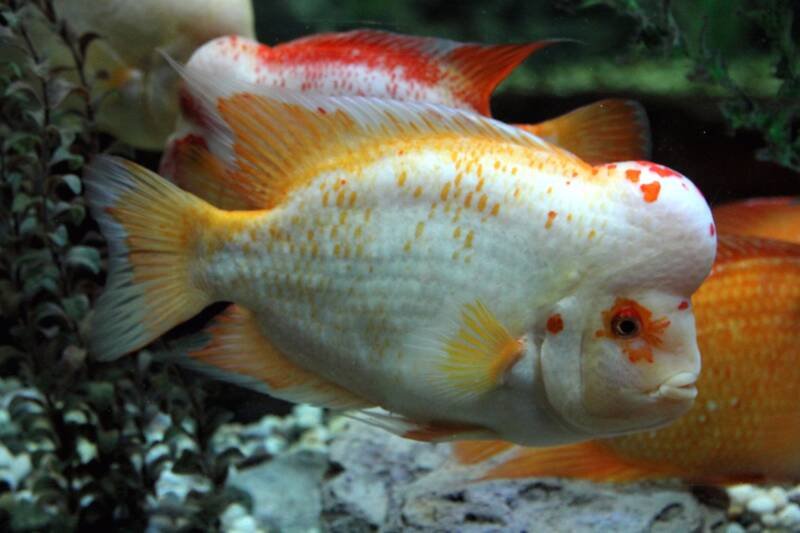
Often mistaken for the Midas cichlid (Amphilophus citrinellus), the red devil has large lips as opposed to the Midas’ thinner ones. Most Red Devils have thick, orange lips, but others have black.
Sexing
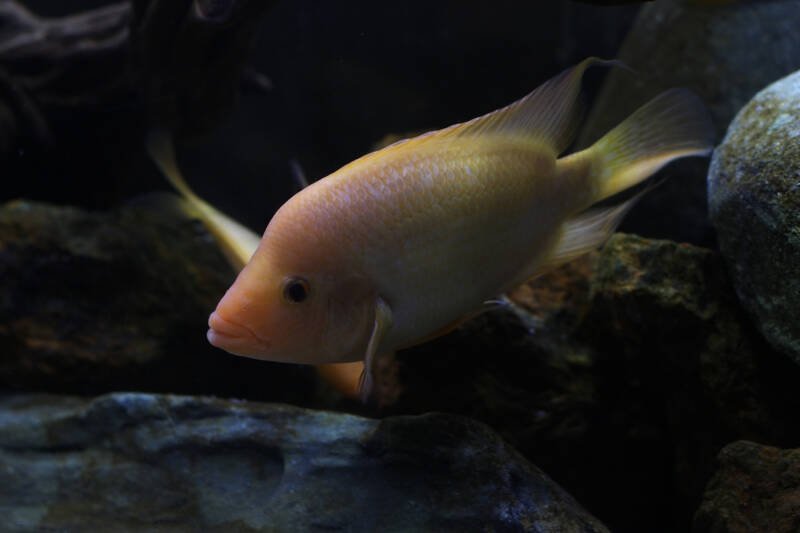
The most noticeable difference between male and female red devils is the male’s nuchal hump, a raised feature on the forehead.
Usually only present at breeding times in nature, this hump can be permanent with fish in captivity.
Another gender difference is the male’s pointed genital papilla, as opposed to the female’s blunt papilla.
Size
A sizable aquarium fish, the red devil can ultimately grow up to 15 inches (38 cm) in length!
Do not be caught unawares as this fish can breed when only six inches (15 cm) long, and it can take up to three years for them to grow to full size.
Lifespan
With good care, the red devil will be part of your aquarium for a long time. They can live anywhere from 10 to 12 years.
Water quality and diet are the biggest determinants for how long your fish will live.
Behavior
Now on to behavior. The red devil cichlid is called that for a reason.
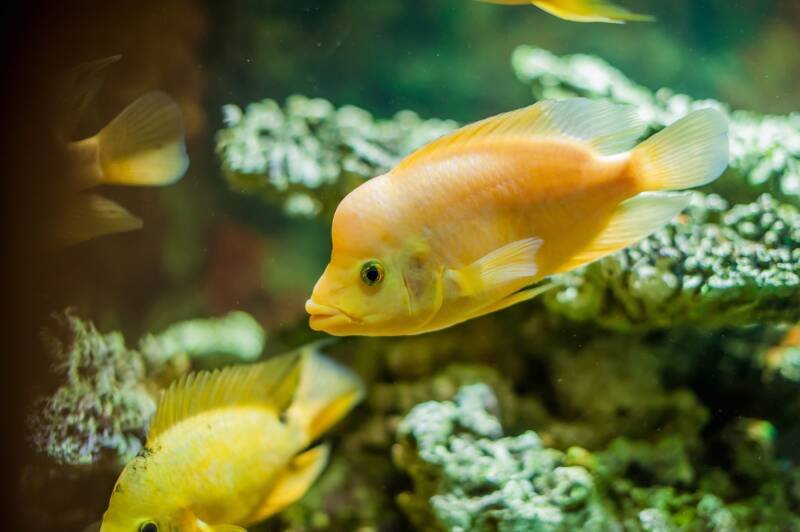
Highly Interactive
Many keepers enjoy the cichlid’s high activity levels and individual personalities.
Some cichlids have been known to react vividly to their owners, much like a dog would. Following their keeper, playfulness, and displaying for attention can all be part of the cichlid’s fascinating and fun behaviors.
Somewhat Aggressive
On the flip side, red devils are an aggressive breed and can direct this aggression toward other species in the tank or even toward one of their own.
While they can be kept with other, similarly-tempered species growing up, they are best kept alone once they are adults.
The best plan is to have a tank large enough to accommodate this territorial fish.
Not only will its activities impact any other fish in the tank, but it will also impact the tank environment. The red devil is an infamous digger and loves to either tear up or uproot aquatic plants.
They can direct these destructive activities to any decorations on the tank’s bottom, such as rocks or driftwood, or toward any unprotected equipment in the tank.
How many per gallon?
Knowing the above behavior traits, a single, full-grown, 15-inch red devil cichlid should be kept in a large aquarium of at least 55 gallons. Yes, that is one fish for a 55-gallon tank.
If you would like to keep a pair of them together, plan on at least 125 gallons.
If you plan to introduce other species, you will need 200 gallons or more.
These larger tank sizes will give the cichlids plenty of room to swim, which often leads to a better behaved, happier fish. With multi-species tanks, the larger amount of space allows for them to establish and defend territories.
Tank setup
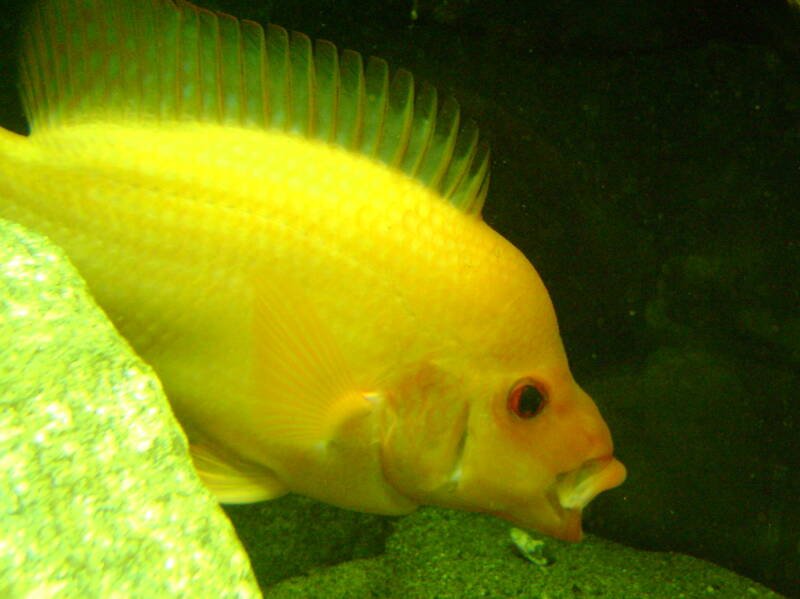
We have already mentioned the need for a minimum tank size of at least 55-gallons for a single red devil cichlid.
Because they like to dig, choose a darker colored, sandy substrate. Add rocks and driftwood to create hiding places, but make sure they are well-embedded or even attached to the tank bottom.
Skip the live plants, as these fish will either eat them, rip them up, or uproot them.
Make sure there is a large, open swimming area.
Water Conditions
Water quality is important to maintain the health of your red devil cichlid.
To prevent the buildup of phosphates, nitrates, and water hardness, replace at least 25% to 30% of the water weekly.
Keep the water temperature between 75 – 79°F (24 to 26°C), with a pH range of 6.5 to 7.5. Water hardness should be between 6 to 25 dGH.
Equipment
While the cichlid can tolerate a range of water conditions, make sure you keep the water well-oxygenated using an air stone or similar device.
Install a filtration system that produces a moderate current. Consider a dual filtration system, using a sump style and/or canister filter.
Protect these equipment items by mounting them externally if possible or placing them behind stable objects that the cichlid cannot easily reach.
There are no special lighting needs, and the cichlid tolerates normal to moderate lighting.
When cleaning the tank, use a siphon to clean waste material from the sandy substrate.
Tank Mates
You may have gotten the idea by now that if you are interested in keeping a red devil cichlid, you may be keeping a single fish.
When young, this breed is generally fine when kept with other fish of similar temperament, but they are best kept alone as they age.
But even then, as the red devils get older, they may turn on their tank mates.
Having a large enough tank, up to 125 gallons if you plan on keeping a breeding pair and 200 gallons or more if you plan on keeping multiple species, can go a long way toward keeping the peace.
Some keepers have placed younger red devils with the following fish such as:
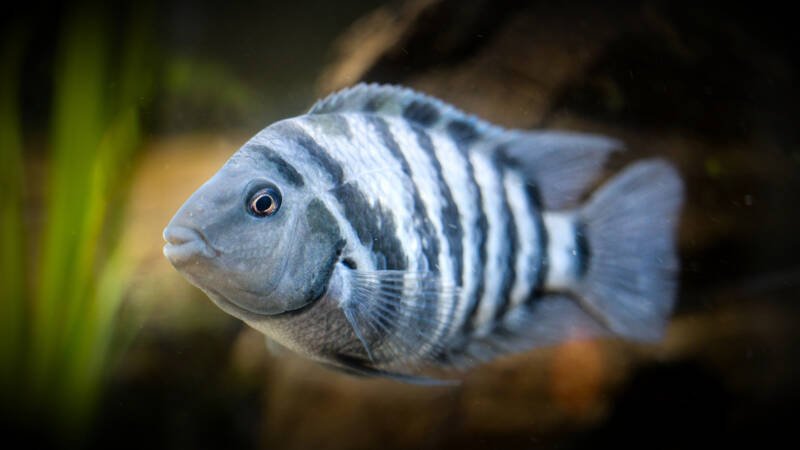
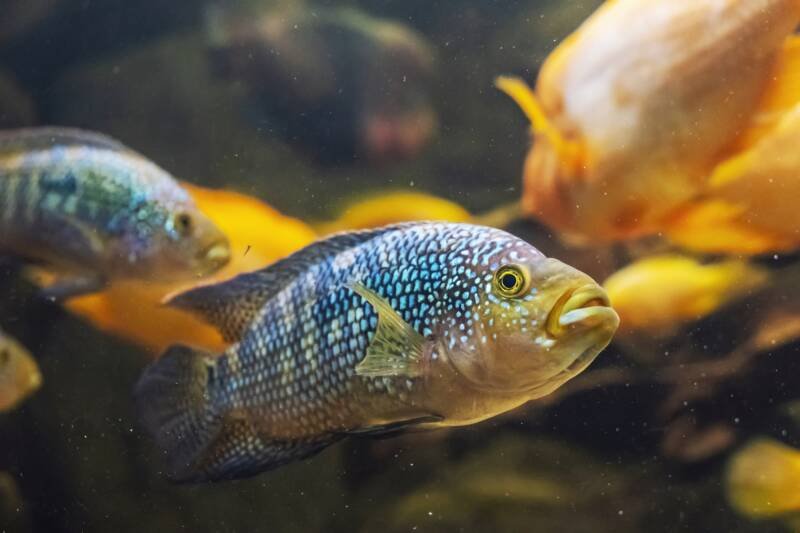
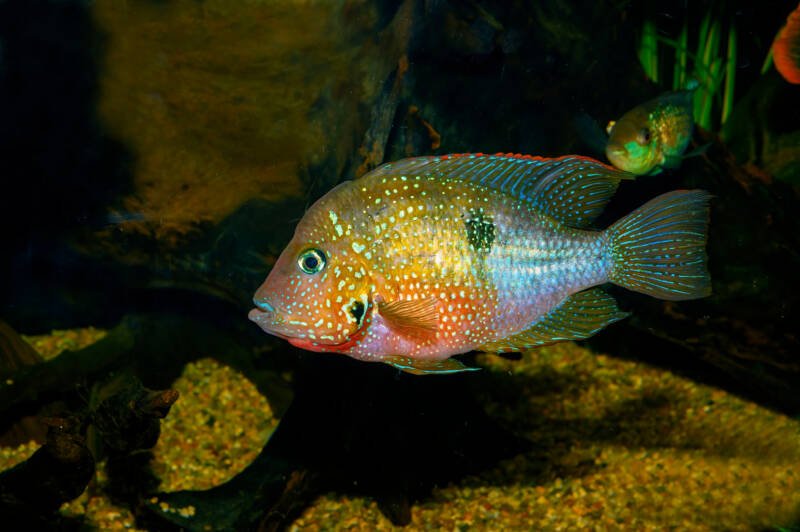
Food and Diet
The red devil cichlid is an omnivore and will basically eat anything.
As with all fish, they do best with a well-balanced diet including live, frozen, and fresh foods in addition to commercial flakes or cichlid pellets.
Cichlids enjoy earthworms, bloodworms, krill, and even crickets, but as omnivores, they need plant foods as well.
Spirulina flakes, lettuce, broccoli, or shelled peas make for good supplements and help your fish to resist common tank illnesses better.
Feed your red devil cichlid several times per day.
Breeding
Breeding red devil cichlids is moderately easy. The fish form breeding pairs and are open spawners, meaning they will lay eggs in open water.
Tank Setup
Condition the breeding pair with nutrient-heavy, live foods. The only real tank setup requirements are a flat or inclined surface area and a water temperature raised to 77 degrees Fahrenheit (25°C ).
Breeding Behavior
The female cichlid will lay anywhere from 600 to 700 eggs on a flat rock or inclined surface area. After three to four days, the clear to yellow-orange eggs will hatch.
Caring for the Fry
There is not much to do to care for the fry. The male and female cichlids will protect them, with the male even digging a hole and moving the fry into it for this purpose.
In five to seven days, the fry become free-swimming. Feed the fry artemia nauplii.
Hardiness
This fish is incredibly hardy and not prone to any specific diseases. However, they can contract common tank illnesses if the water conditions are poor.
Ich is one common problem that can be treated by correcting the water conditions and using a specific medication if needed.
Another concern is “hole in the head” disease. Also attributed to poor water conditions or diet, you will see a pit or hole on your fish’s head or face. Make sure to adequately filter your water to help avoid this illness.
Red devil cichlids are also prone to parasites, such as protozoa or worms, as well as infections due to fungus or bacteria.
Properly clean any new items that you add to your tank, regularly replace 25% to 30% of the tank water, and install adequate filters.
Final Recommendations
Despite their hardy nature, red devil cichlids are best kept by someone familiar with their temperament and needs.
Their aggressive nature necessitates routine tank monitoring if they are kept with other fish.
They are easily found in fish stores and online, typically costing around $18 per fish.
Their aggressive nature necessitates routine tank monitoring if they are kept with other fish.
There are moderate tank commitments as well, as you will need at least a 55-gallon tank for one fish.
In addition, efficient dual filters and air stones will help keep your fish’s environment healthy. Plan on performing regular tank maintenance to avoid your fish contracting common tank ailments.
That said, for those eager to take them on, the red devil cichlid is a wonderfully active fish that can react to and bond with its keeper.
Have you kept a red devil cichlid?
Which filtration combinations have you used to keep the water quality high?